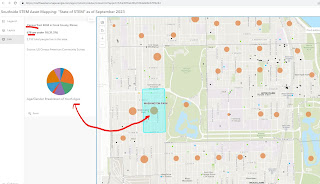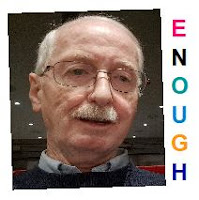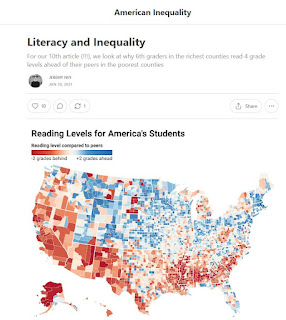Today I explored a robust data visualization site created by Argonne Labs in partnership with Northwestern University’s Digital Youth Network. The
home page of the website is shown below.
Click on any of the green circles and you'll open data tables for nine communities on Chicago’s south side, cataloguing STEM assets from Kindergarten to career.
The nine focus communities are shown in the map on the home page. Open
this link and you'll find an interactive version. Below are some map views that I created in just a few minutes.
Click on the "layers" tab and you will see a menu of choices for what you want to show on your map. For instance.
This view shows community organizations in the area who offer various forms of STEM learning opportunities. The orange circles show census data for each census tract in the nine community areas.
In the map view above I've clicked on an icon for the Chicago Youth Programs site at 5350 S. Prairie Ave. You can see program information in the text box to the left of the map. This is an organization I've know for many years and is also included in my list of Chicago area volunteer-based tutor, mentor and learning programs.
Below is a map view where I've clicked on the orange circle for the census tract with the Chicago Youth Programs location. I asked for information showing the number of youth under age 18 in the area. The map shows 678 kids out of a population of 2152 in that census tract.
The next map view shows businesses, or potential employers, in the nine community areas. Put your curser over any black dot and find information showing who that business is. Zoom in to see what businesses are in different census tracts.
There is a lot to explore. Here's
an article about the platform, posted in the Block Club Chicago publication.
My question is, "How will it be used to make STEM learning and career opportunities available to youth through out the area?"
I've met in the past two years with the people who created this platform and encouraged them to dig into the history of the Tutor/Mentor Connection and the tools and strategies we piloted from 1993 to 2011 to help volunteer-based tutor/mentor programs grow in the Chicago region. This
Mapping for Justice blog is a textbook for anyone who wants to use it that way. Just read some of the "
strategy" articles.
I started building a
list of Chicago tutor/mentor programs in 1993 and at the same time began learning ways to use GIS mapping to show where the programs were located and where more were needed. We published our first Directory in May 1994 at the same time as we hosted our first networking conference. We used the directory to launch citywide volunteer recruitment campaigns in August 1995.
In 2004 an intern from India built the first on-line Tutor/Mentor Program Locator, which was a searchable database shown below. We had organized our annual survey in 1994 to learn who offers volunteer-based tutor/mentor programs, where they were located, what age group they served, and what type of tutoring and/or mentoring did they offer, as well as what time of day did they offer services.
The search fields on the Program Locator enabled people to search for specific programs based on the categories of our survey. This worked like most search engines. If you had an idea of what you were looking for, and where, the platform helped you narrow your search and find tutor/mentor program information in that area.
In 2008 a team from India built a new version of the Program Locator. The home page is shown below. This works differently from Google. It starts with a map of a specific area, then shows layers of information, including our data on Chicago tutor, mentor programs.
At the left you can see layers of information that can be displayed on the map. These layers included our data about Chicago tutor/mentor programs, but also included poverty data, poorly performing schools, and assets (businesses, faith groups, colleges, hospitals) etc.
Thus, you could create a map showing the entire city.
Or you could zoom in and create a map view showing a portion of the city.
You could add text to the map to focus on specific organizations in various community areas.
You could follow news stories with map stories. On your map you could not only show existing tutor/mentor programs, but you could add layers showing businesses, hospitals, faith groups, universities who share the same geography and who should be innovative and strategic in helping mentor-rich non-school programs grow in the area. For each part of the city the mix of programs and assets is different.
The Program Locator is now only available as an archive. However, you can see some of the features in this PDF essay.
How to Use Chicago Tutor/Me... by Daniel F. Bassill
One of the challenges of the STEM project is building public awareness and drawing people to the platform, then teaching them to create stories on a regular basis that draw even more people to the platform and motivate them to take actions that help kids in the area have access to mentor-rich STEM learning programs that provide on-going support as kids move from 1st grade through high school, college/tech school and into jobs and careers.
Since my organization did not have advertising dollars we developed a "Rest of the Story" strategy that followed media stories with maps that showed the neighborhood and pointed to tutor/mentor programs in the area (if any) and described the need for more programs. Below is a mid 1990s example.
The STEM project leaders could duplicate this and other strategies that I've piloted over the past 30 years. They are all on-line and available to anyone motivated to look. They might even add some features and functionality to their platform based on what I have done, or tried to do.
The Tutor/Mentor Blog is an even broader text book than the Mapping For Justice blog. Think of the sections below as chapters, or courses in a learning curriculum.
Public awareness - click here
Using maps - click here
Media strategies - click here
Follow up to violence - click here
Mentor role in larger strategy - click here
Tutor/Mentor Institute, LLC website - click here
The challenge: Too much information.
View this graphic in this article. The ideas I share and websites I point to are a vast information ecosystem. It's like a university library or the library of different religious groups. It can't be learned in a day. It needs to be part of on-going learning.
For that to happen major donors, perhaps MacKenzie Scott, need to provide money to fund programs within high schools and college that provide advance degrees for people who spend 10-20 years learning and applying these ideas.
Thanks for reading. Please share these ideas with leaders in Chicago and other cities. Maybe you know one of these donors, or are one yourself.
Connect with me on social media platforms and share your own strategies and maps. Help build the network. Help the STEM network grow and reach more people.
Finally, consider a year-end contribution to help me continue this work in 2024. Visit this page to use the PayPal.









































